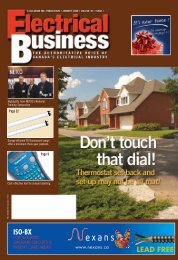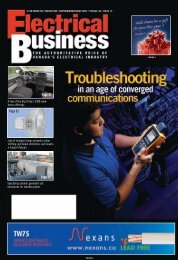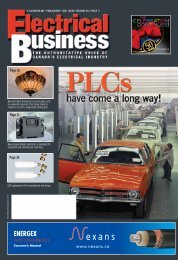Download - Electrical Business Magazine
Download - Electrical Business Magazine
Download - Electrical Business Magazine
Create successful ePaper yourself
Turn your PDF publications into a flip-book with our unique Google optimized e-Paper software.
Are you ready forTechReady?Jump into the world of residential low-voltageBy Karen WeickertIn today’s world of continuous technological evolutions, weare constantly being challenged to upgrade our skills—bothon personal and professional levels. Gone are the days wherewe felt certain we could navigate this world with more skill andability than an average 12-year-old; where setting up a TV isno longer simplistic; and where piecing together the puzzle ofinstalling a brand-new, wall-mounted HDTV is as easy as solvingthe Da Vinci Code. We are at a crossroads.As an electrician, you can continue down the normal roadof high-voltage work, where there is comfort and consistencyin your area of expertise. However, there just might be aworld of opportunity out there for the brave souls willingto take the road that includes a deeper understanding oflow-voltage technologies.A quick look at some research being conducted south ofthe border by the Consumer Electronics Association (CEA)shows that home builders are looking to their electrical contractorsfor low-voltage work. For instance, the 6th AnnualState of the Builder Technology Market Study (2007) has achart entitled: Type of Installation Contractor Used for HomeTechnologies. It shows that the use of electrical contractorshas grown from 63% in 2006 to 72% in 2007.So it’s all good, right?Well, maybe. Since numbers can be a tricky thing, let’s looka little more closely at those numbers and see what they mayor may not indicate for the our marketplace. When you lookfurther back than 2006, the chart shows the following data:2002 2003 2004 2005 2006 200776% 76% 65% 67% 63% 72%Given the electrical contractor was being used at the rate of76% in 2002 and 2003, the 9% increase from 2006 to 2007is really a 4% decline over the previous five years. So whatcreated the original decline in the use electrical contractorsthat started in 2004?I would hazard a guess that the answer is the introduction ofincreasingly more sophisticated technologies going into newhomes that required a specific skill set and level of expertisethat the average electrical contractor had not yet acquired.Many of the discussions and presentations I attended atthe Electronic House Expo (EHX) in March 2007 betrayeda deepening frustration among builders and integrators(professionally trained low-voltage installers) with untrainedelectricians doing low-voltage work.So what does this mean for the Canadian electrical contractor?Well, market behaviour shows that, when it comes to theadoption of new technologies, Canadians lag the Americanmarketplace by three to five years. So, were we to work that laginto the equation, we should find that the Canadian electricalcontractor is experiencing a decline in low-voltage work—similar to the 2004 trend indicated in the chart above. (Wewould certainly see support for this theory in the AtlanticProvinces, where more security companies and specializedlow-voltage cabling companies are scooping up low-voltagework in the new home construction industry.)But what about the sudden increase in the use of electricalcontractors indicated in the chart for 2007? The CEA reportspeculates that electrical contractors are beginning to add specialized,low-voltage services that are beneficial to builders. Couldit be that electrical contractors have recognized the opportunitybefore them, and taken steps to offer quality specialized servicesto home builders? Does this same opportunity lay before theaverage Canadian residential electrical contractor?TechReady says: Yes!What does TechReady do to homes?TechReady is a joint initiative between Bell Aliant and participatinghome builders’ associations designed to promotethe advancement of standards-based low-voltage wiring in theresidential building industry. The program has been designedto train builders, renovators and subcontractors to properlywire new homes according to international standards for currentand future technology.Here’s how a TechReady home differs from an averagebuild. The typical new home may have four coax and maybeseveral Cat 5e cables run throughout. A TechReady home, onthe other hand, will boast: 5 coax; 11 Cat 5e (if not Cat 6); 4backbone cables; a distribution device with components andelectrical outlet; RJ45 jacks; completely terminated.Is this overkill? Not at all, as the numbers prove out thisinvestment. CEA says the consumer electronics market hasgrown from $98.4 billion in 2002 to $171 billion in 2008,and whereas the 2006 ‘connected’ home required speeds of28Mb/s for transmitting information, the 2010 home isexpected to require 60Mb/s. The home of the not-too-distantpast only had to support one ‘family’ computer. But homesthese days often have more than one computer, and consumersare increasingly buying/installing things like:• theatre/media/entertainment systems• home healthcare products• media centre edition (MCE) computers• micro-display-based televisions• lighting and automation (let’s not forget‘talking’ refrigerators)• security systems• media servers• gaming roomsAnd a really strong selling feature of a TechReady home is thatthe cost of the low-voltage infrastructure can be incorporatedinto the mortgage. So rather than pay thousands of dollarsto retrofit an existing home for advanced technologies, thehome owner pays $0.25/day for a basic system or $1.25/dayfor an advanced communications infrastructure (based on a20-year mortgage at 6.5% interest for a $300,000 home).What consumer wouldn’t want this?Are you ready to become TechReady?Since its initial launch in September 2007 in Nova Scotia,TechReady has grown into the New Brunswick marketplaceand expects to have a presence in Newfoundland & Labradoras well as Prince Edward Island in early 2009. It has currentlytrained over 100 industry personnel and has over 100 registeredTechReady homes. Even more impressive, two TechReadybuilders have implemented plans to make their entire subdivisionsTechReady. This represents more than 600 homes in thesetwo subdivisions alone over the next five to eight years.TechReady has even been recognized with two nationalawards presented by the Canadian Home Builder’s Associationfor The Best New Idea in 2007 and the Dave Bell MemorialTrophy for Education and Training.A Nova Scotia builder, Steve Bartlett of KelGreg HomesInc., endorses the program. “I feel that TechReady helps showour clients our commitment to innovation in housing to suitour changing world. By building all homes TechReady, we—aswell as our clients—are confident that the new home is functionalfor today’s technology and prepared for the changesof tomorrow. I also believe that TechReady has increased thecredibility of our company, as it is an attractive feature.”In addition to training the building industry, TechReady aimsto serve the consumer by creating a recognizable brand thateasily identifies quality infrastructure within a home. Havinga properly wired home is a necessity in today’s environment ofhigh-speed Internet, IPTV and advanced home entertainmentand control systems. TechReady offers home owners the assurancethat one of the biggest investments in lives—their newhome—is well prepared for current and future services.So if you’re an electrical contractor working in AtlanticCanada, you’re in luck: you have a means to get the informationand training you need to stay current and marketable inthe world of low-voltage technologies. Be sure to check outwww.techready.ca (being revamped at the time of writing toinclude additional information) to learn more, or contactyour local home builders’ association. Inquiries outside of theAtlantic Provinces can be directed to Bell Aliant ProfessionalServices at (877) 865-1057.Karen Weickert is with Bell Aliant’s Professional Services, BuildingIndustry Consulting.Photos by Anita MacPherson • AMac Photography16 • november/december 2008 • www. mag.com
















